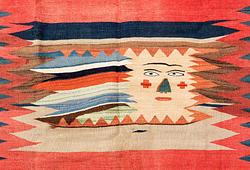Anders Zorn
"Dam med flor (förstudie till "Sorg")" (Woman behind a veil)
Executed around 1880. Watercolour, image 30 x 22 cm.
Literature
Probably identical with "Konst i svenska hem II" band 2, upptagen sid 92 under samling 74: "Doktorinnan Anna Hwass, Östermalmsgatan 45, Stockholm)".
More information
The auction's painting "Dam med flor" is a study for Anders Zorn's famous work "I sorg," a watercolour that marked his breakthrough at the Royal Academy's student exhibition in 1880. "Dam med flor" displays clear traits of Zorn's early, emotive portrait style, where he explores the expression of sorrow through subtle details and a sparse yet effective colour palette. As in "I sorg," we see here a young woman whose downcast gaze and face, partially concealed by a delicate veil, convey a sense of melancholy and inner calm. It is an introspective depiction, where sorrow is suggested rather than explicitly expressed.
In this painting, Zorn employs colour and light to highlight the woman's expression and create contrast against the background. The vibrant details in her hat, along with the model's fair complexion, create a distinct interplay between light and shadow. Against the warm background colour, the woman's face and veil are accentuated, drawing the viewer's gaze towards the centre of the subject and adding depth to the image.
According to reports, the woman in the auction's painting is Emma Zorn, Anders Zorn's future wife, who was then known as Emma Lamm. Anders and Emma married in secret in October 1885 after having met four years earlier when Zorn was to paint a portrait of Emma's nephew.
The auction work was likely executed around 1880 and is a brilliant example of Zorn's technical skill as a watercolourist and his ability to capture emotions and presence with subtle precision. With masterful handling and a keen sense of the human inner life, Zorn has here created an image that is not only a study in technique but also an intimate portrayal of sorrow and stillness, inviting the viewer to share in the model's emotional landscape.
Artist
Anders Zorn, born in Mora in 1860, showed artistic talent from a young age. In 1875, he traveled to Stockholm and became a student at the then Slöjdskolan (now Tekniska högskolan) in Stockholm, and shortly after, he joined the Royal Academy of Fine Arts. Initially, Zorn had aspirations of becoming a sculptor, but soon watercolor painting took over, becoming his primary medium until 1887. At the student exhibition in 1880, Zorn had his breakthrough with the watercolor painting "I sorg." The following year, he gained international acclaim as a portrait painter. His watercolor painting reached its pinnacle during this period, and his most famous work from this time is "Vårt dagliga bröd” from 1886. Shortly thereafter, Zorn transitioned to oil painting, which was met with immediate success. Zorn's reputation mainly rested on his portrait art, and he portrayed many notable figures, including presidents. For instance, he created an etching of Theodore Roosevelt. His etchings significantly contributed to his success. In the late 1880s, Zorn began working in the genre that would increasingly become his trademark: nude figures in outdoor settings. He had long been fascinated by the movement of water and the reflections of light on its surface. Now, he added the complexity of placing a model near or in the water, aiming to depict a synthesis between nature and humanity. In 1896, Zorn and his wife moved back to Sweden and settled in Zorngården in Mora. This move sparked a renewed interest in his homeland, which would be reflected in his future paintings. Among the artist's scenes from the Mora region, portraying its local customs and ancient traditions, "Midsommardansen" holds the highest value according to Zorn himself. Today, the painting can be found at the National Museum.
Read more

































